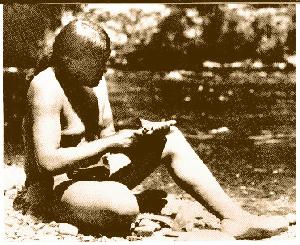

 Ishi's story is a fascinating and controversial one. To some he embodies the tragic effects of Euro-american culture on the lives and cultures of Native Americans. Others question the motives of the scientists who befriended him. But there can be no question that the information he left us is invaluable.
Ishi's story is a fascinating and controversial one. To some he embodies the tragic effects of Euro-american culture on the lives and cultures of Native Americans. Others question the motives of the scientists who befriended him. But there can be no question that the information he left us is invaluable.Ishi was a Yahi Indian, the last of his tribe, who once populated north-central California. The Yahi were members of the Yana nation. The gold rush flooded California with Europeans. There was no place in 'white' California for the natives and they were killed or driven from their homelands. Ishi and a handful of his relatives spent their life hiding in the foothills of Mount Lassen. Over the years these people passed away, until Ishi was the only one remaining.
Alone and driven by hunger, in 1911 Ishi approached the Northern California town of Oroville. Here he was 'disovered'. Attitudes had changed since the gold rush of the late 1800's and no one knew what to do with him. No one could understand his language and. For lack of a better idea, he was taken to the town jail. Not because he was under arrest but because nobody knew what to do with him. It was also to buffer him from the throngs of gawkers who came to stare at him. He was fed and given clothes. These were in a style foreign to Ishi, but sensing the townspeople's good intentions he ate their food and put on their clothes. All except their shoes which he kindly refused in favor of going barefoot.
Two professors at the Museum of Anthropology of the University of California in San Fransisco, learned of Ishi's situation and Professor Waterman was soon on the train headed to Oroville. Ishi accompanied Waterman back to the Museum. At the Museum, he was soon befriended by Alfred Kroeber, a young anthropologist who knew a few words in Ishi's language. Ishi lived at the museum until his death from tuberculosis in 1916. In that time he taught us about his people and their traditional way of life. He showed us how the Yahi lived; how they built their dwellings and crafted their tools, how they hunted and how they fished. Through his student, Saxton Pope, he introduced Americans to archery.
He also taught us a lot about flintknapping. Kroeber was amazed with his ability to turn obsidian or even broken bottle glass into beautiful and functional arrowheads. Using iron pressure flakers made from discarded nails in wooden handles, Ishi crafted his delicate projectile points. He showed us how to haft these points on arrows, and how to craft the bows to shoot them. From Ishi we learned how to use these bows and butcher the animals that were hunted. He showed us how to prepare the meat and use the hide and bones for clothing and tools.
 Back to Interpreting
Stone Tools.
Back to Interpreting
Stone Tools.  Return to the Main
Page.
Return to the Main
Page.